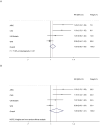This is a preprint.
Genetic Ancestry and Risk of Atrial Fibrillation in Individuals of Black Ethnicity in the UK Biobank
- PMID: 40791710
- PMCID: PMC12338908
- DOI: 10.1101/2025.07.12.25331418
Genetic Ancestry and Risk of Atrial Fibrillation in Individuals of Black Ethnicity in the UK Biobank
Abstract
Background: Black individuals have a lower incidence of atrial fibrillation (AF) than White individuals, despite a higher burden of traditional risk factors. Prior studies have suggested that European genetic ancestry may contribute to this paradox, but findings have been inconsistent.
Methods: We examined the association between European genetic ancestry and incident AF among 6,920 UK Biobank (UKB) participants who self-identified as Black and were free of AF at baseline. European ancestry proportions were estimated by comparing participants to HapMap reference populations and were analyzed both continuously and categorically using Cox proportional hazards models. Non-linear associations were evaluated using flexible hazard ratio spline curves. We then conducted a meta-analysis combining these results with those from the Atherosclerosis Risk in Communities Study, the Cardiovascular Health Study, and the Women's Health Initiative (WHI).
Results: During a median follow-up of 13.7 years, 205 (3%) participants developed incident AF. Each 10% increase in European ancestry was nominally associated with increased AF risk (HR 1.07, 95% CI: 0.95-1.20), and individuals in the highest ancestry category had a higher AF incidence rate. Random-effects meta-analysis of all four cohorts yielded a pooled relative risk (RR) of 1.09 (95% CI: 0.99-1.21), with substantial heterogeneity largely driven by the WHI study. Excluding WHI resulted in a pooled estimate (RR 1.14, 95% CI: 1.05-1.23) without heterogeneity.
Conclusion: Our findings suggest a modest association between European genetic ancestry and increased AF risk among admixed Black individuals. Future studies should confirm these results, explore underlying mechanisms, and assess their clinical implications.
Figures



Similar articles
-
Intravenous magnesium sulphate and sotalol for prevention of atrial fibrillation after coronary artery bypass surgery: a systematic review and economic evaluation.Health Technol Assess. 2008 Jun;12(28):iii-iv, ix-95. doi: 10.3310/hta12280. Health Technol Assess. 2008. PMID: 18547499
-
Prescription of Controlled Substances: Benefits and Risks.2025 Jul 6. In: StatPearls [Internet]. Treasure Island (FL): StatPearls Publishing; 2025 Jan–. 2025 Jul 6. In: StatPearls [Internet]. Treasure Island (FL): StatPearls Publishing; 2025 Jan–. PMID: 30726003 Free Books & Documents.
-
Healthcare outcomes assessed with observational study designs compared with those assessed in randomized trials.Cochrane Database Syst Rev. 2014 Apr 29;2014(4):MR000034. doi: 10.1002/14651858.MR000034.pub2. Cochrane Database Syst Rev. 2014. Update in: Cochrane Database Syst Rev. 2024 Jan 4;1:MR000034. doi: 10.1002/14651858.MR000034.pub3. PMID: 24782322 Free PMC article. Updated.
-
Falls prevention interventions for community-dwelling older adults: systematic review and meta-analysis of benefits, harms, and patient values and preferences.Syst Rev. 2024 Nov 26;13(1):289. doi: 10.1186/s13643-024-02681-3. Syst Rev. 2024. PMID: 39593159 Free PMC article.
-
Resting Heart Rate and Incident Atrial Fibrillation in Black Adults in the Jackson Heart Study.JAMA Netw Open. 2024 Oct 1;7(10):e2442319. doi: 10.1001/jamanetworkopen.2024.42319. JAMA Netw Open. 2024. PMID: 39476232 Free PMC article.
References
-
- Alonso A, Krijthe BP, Aspelund T, Stepas KA, Pencina MJ, Moser CB, Sinner MF, Sotoodehnia N, Fontes JD, Janssens ACJW, Kronmal RA, Magnani JW, Witteman JC, Chamberlain AM, Lubitz SA, Schnabel RB, Agarwal SK, McManus DD, Ellinor PT, Larson MG, Burke GL, Launer LJ, Hofman A, Levy D, Gottdiener JS, Kääb S, Couper D, Harris TB, Soliman EZ, Stricker BHC, Gudnason V, Heckbert SR and Benjamin EJ. Simple risk model predicts incidence of atrial fibrillation in a racially and geographically diverse population: the CHARGE-AF Consortium. J Am Heart Assoc. 2013;2:e000102. - PMC - PubMed
-
- Rodriguez CJ, Soliman EZ, Alonso A, Swett K, Okin PM, Goff DC Jr. and Heckbert SR. Atrial fibrillation incidence and risk factors in relation to race-ethnicity and the population attributable fraction of atrial fibrillation risk factors: the Multi-Ethnic Study of Atherosclerosis. Ann Epidemiol. 2015;25:71–77. - PMC - PubMed
-
- Alonso A, Alam AB, Kamel H, Subbian V, Qian J, Boerwinkle E, Cicek M, Clark CR, Cohn EG, Gebo KA, Loperena-Cortes R, Mayo KR, Mockrin S, Ohno-Machado L, Schully SD, Ramirez AH and Greenland P. Epidemiology of atrial fibrillation in the All of Us Research Program. PLoS One. 2022;17:e0265498. - PMC - PubMed
Publication types
Grants and funding
LinkOut - more resources
Full Text Sources
